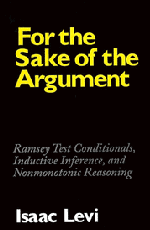 For the Sake of the Argument
For the Sake of the Argument This book has its origins in conversations I had with André Fuhrmann at the meetings of the International Congress of Logic, Methodology, and Philosphy of Science in Uppsala in 1991. These exchanges led to a joint essay (Fuhrmann and Levi, 1994) that discussed some peculiarities of conditional reasoning when induction is taken into consideration. One sin begets another and I began contemplating the writing of a long paper combining the version of Ramsey test conditionals I had already advocated with ideas on inductive inference I had discussed ever since I had published Gambling with Truth (Levi, 1967).
As a preliminary, however, it seemed desirable to spell out somewhat more elaborately than I had done before the view of Ramsey test conditionals I favor. At around the same time, John Collins and I started a reading group at Columbia that included as regular participants Markko Ahtisaari, Horacio Arlo Costa, John Danaher, Scott Shapiro, and, for a brief period when he was visiting Columbia, André Fuhrmann. John Collins had presented to the group his account of the structural differences between revision of belief as understood by Alchourrón, Gardenfors, and Makinson (1985) and revision by imaging in a sense parasitic on the possible-worlds semantics for conditionals pioneered by D. Lewis (1973). In the course of his presentations, Collins defended the view that imaging was best suited to characterizing suppositional reasoning whereas AGM revision is suited to changing beliefs. I had already argued (Levi, 1991) that the AGM formalism was inadequate as an account of rational belief change. And I was quite convinced that imaging was ill suited to capture suppositional reasoning – especially in applications to practical deliberations.
To save this book to your Kindle, first ensure [email protected] is added to your Approved Personal Document E-mail List under your Personal Document Settings on the Manage Your Content and Devices page of your Amazon account. Then enter the ‘name’ part of your Kindle email address below. Find out more about saving to your Kindle.
Note you can select to save to either the @free.kindle.com or @kindle.com variations. ‘@free.kindle.com’ emails are free but can only be saved to your device when it is connected to wi-fi. ‘@kindle.com’ emails can be delivered even when you are not connected to wi-fi, but note that service fees apply.
Find out more about the Kindle Personal Document Service.
To save content items to your account, please confirm that you agree to abide by our usage policies. If this is the first time you use this feature, you will be asked to authorise Cambridge Core to connect with your account. Find out more about saving content to Dropbox.
To save content items to your account, please confirm that you agree to abide by our usage policies. If this is the first time you use this feature, you will be asked to authorise Cambridge Core to connect with your account. Find out more about saving content to Google Drive.